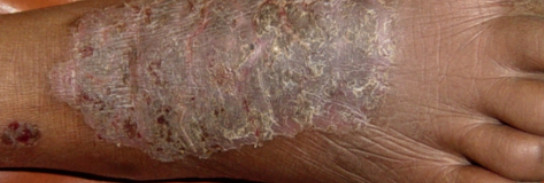
Lichen Simplex Chronicus treatment options
Tips
- The aim of the treatment is to break the itch-scratch cycle and to treat the underlying conditions.
- Treatment options should be individualized according to the patient’s age, pre-existing diseases, medications, quality and intensity of pruritus.
- Explain to the patient that pruritus is not just a symptom of LSC but it may be the cause.
- The patient should be told that long term treatment is usually needed.
- Pruritus-relieving measures are helpful.
- Occlusion may have a role as it provides a physical barrier against itching and permits enhanced absorption of topical drugs.
- Psychiatric consultation and psychotherapy may be recommended in some patients.
- Underlying stress should be treated.
- Advise your patients to keep their nail cut.
- In case of genital cases, fungal infection should be excluded.
- Biopsy may be considered to exclude diseases such as psoriasis or mycosis fungoides.
- In refractory or unusual cases, systemic disease and malignancy should be ruled out.
- Antibiotics may be necessary if secondary infection is present.
Topical treatment options
Pruritus-Relieving Measures
- Wet and cold wraps.
- Lotio alba application.
- Short-time localised heat.
- Cool to tepid baths.
- Unna boot : a gauze roll impregnated with zinc oxide may be tried for difficult cases.
Topical steroids
- Halobetasol propionate : twice daily for 2 weeks.
- Flurandrenolide tape is effective.
- Clobetasol foams are very effective and can be used for lesions on the neck, legs, wrists, ankles, and vulva.
- Intertriginous areas respond to group V or VI topical steroids.
- Intralesional triamcinolone acetonide (excoriated or infected lesions should not be injected) 10 mg/ml for resistant nodular lesions.
Urea preparations
- Hydrocortisone and urea combination my be helpful.
Doxepin
- Doxepin 5 % cream.
Others
- Capsaicin 0.25% applied five times daily.
- Cannabinoid receptor agonists
- Local anaesthetics ( short term effect, used topically and intralesional)
- Benzocaine
- Lidocaine
- Pramoxine
- Prilocaine and lidocaine mixture.
- Topical calcineurin inhibitors
- Tacrolimus 0.1% ointment for 9 months.
- Pimecrolimus 1% cream: twice daily for 3 months.
- Zinc oxide, menthol and camphor.
- Mast cell inhibitors
- Topical sodium cromoglycate.
- Botulinum toxin A injected intradermally into lichenified lesions may block acetylcholine release and control pruritus.
- Topical aspirin/dichloromethane solution.
Systemic treatment options
- Antihistamines
- Sedating antihistamines
- Second generation antihistamines: cetirizine, levocetirizine, loratadine, desloratadine, ebastine, fexofenadine and rupafine.
- Opioid receptor agonists and antagonists (use with caution)
- Nalmefene, naloxone and naltrexone.
- Anticonvulsants
- Gabapentin : 300 mg/day and titrated up by 300 mg/ day every 3 days to a final dose of 900 mg/day.
- pregabalin.
- Tricyclic antidepressants
- Oral doxepin 30–75 mg daily.
- Antidepressants
- Leukotriene receptor antagonists
- Montelukast.
- Zafirlukast
- Short course ( 2 weeks) prednisone (20 mg twice daily) should be considered when an extensively inflamed.
- Botulinum toxin A injected intradermally into lichenified lesions may block acetylcholine release and control pruritus, 20 units of botulinum toxin type A (100 U/mL) per 2 cm × 2 cm area of an LSC plaque.
- Cyclosporin
- Aprepitant
Physical treatment options
- Phototherapy with UVA and/or UVB
- Cryosurgery for nodular lesions.
- Transcutaneous electrical nerve stimulation: 30-minute treatments were given thrice weekly for 4 weeks.
- Surgical excision for resistant nodules.
- Focused ultrasound therapy
Other options
- Behavioral treatment : learning the patient how to stop scratching.
- Hypnotherapy: